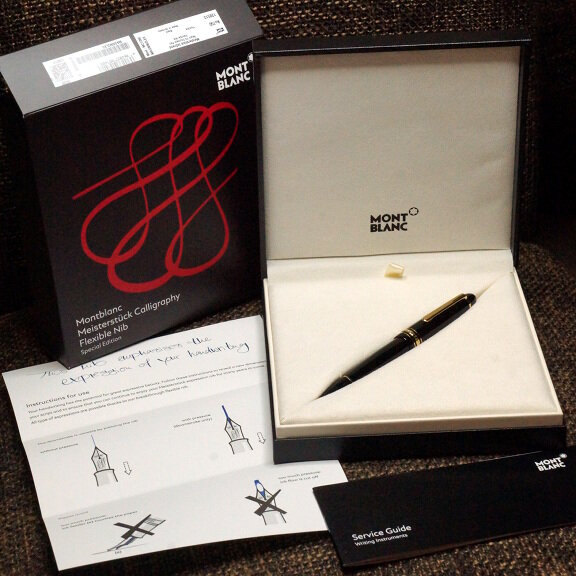Search the Community
Showing results for tags 'calligraphy'.
-
Doing some Chinese character studies of the most commonly used characters. I intend to do one a day for at least 1000 characters! It's fun and you should totally join me in this journey! Feel free to do your own character study and post it in the gallery (or here in this thread)! Today I will do the character 的. In Chinese, the character 的 is one of the most commonly used characters and serves several grammatical functions. Its primary usage is as a possessive particle, indicating possession or association. Here's a breakdown of its main functions: 1. Possessive Particle: 的 is commonly used to indicate possession or association between nouns. For example: - 我的书 - "my book" - 他的车 - "his car" - 中国的文化 - "Chinese culture" 2. Adjectival Modifier: 的 can also be used to turn a phrase or clause into an adjective to modify a noun. For example: - 美丽的花 (měilì de huā) - "beautiful flowers" - 好吃的食物 (hǎochī de shíwù) - "delicious food" 3. Nominalizing Suffix: In some cases, 的 is used to turn a verb or a phrase into a noun. For example: - 做饭的 (zuòfàn de) - "the one who cooks" or "cooking" - 看书的 (kànshū de) - "the one who reads" or "reading" 4. Emphasizing Possession: Sometimes, "的" is used for emphasis, especially in written or literary contexts. For example: - 他的书 (tā de shū) - "his book" (standard) - 他书的 (tā shū de) - "his book" (emphasizing possession) 5. Part of Compound Words: "的" is also used as a component in many compound words and phrases, such as "的确" (díquè) meaning "indeed" or "certainly," or "安全的" (ānquán de) meaning "safe." Overall, "的" is an indispensable character in Chinese, playing a crucial role in indicating possession, forming adjectives, nominalizing phrases, and more. Its versatility and frequency of use make it an essential element of the language. Pens/Inks: Kuretake Fountain Pen Brush No. 50 with original pigment cartridge, Pilot Prera F with Pilot Black Paper: A5 Stalogy 365 full year size Notes: I will be using both traditional and simplified characters, view at your own discretion. This is not a lesson in Chinese language, will be mostly focusing on the calligraphy and aesthetics. I will do the calligraphy in traditional character and brief explanation in English scattered with traditional or simplified Chinese. In addition to the regular script, I will experiment with other scripts like the ancient "small seal" script.
- 21 replies
-
- chinese
- calligraphy
- (and 5 more)
-
From the album: j1tters
A self-correction note: the horizontal strokes are a little unevenly spaced in 首 in the regular script, and perhaps the 辶 shouldn't be touching the 首; not the easiest character to write. In hindsight I really should be practising the characters on a spare sheet of paper before writing this in my journal. But I guess I am too lazy to have done that. I may (or not!) try to be more mindful next time.
- 0 B
- x
-
- chinese calligraphy
- calligraphy
- (and 3 more)
-
From the album: j1tters
Doing some Chinese character studies of the most commonly used characters. I intend to do one a day for at least 1000 characters! It's fun and you should totally join me in this journey! Feel free to do your own character study and post it in the gallery! Today I will do the character 的. In Chinese, the character 的 is one of the most commonly used characters and serves several grammatical functions. Its primary usage is as a possessive particle, indicating possession or association. Here's a breakdown of its main functions: 1. Possessive Particle: 的 is commonly used to indicate possession or association between nouns. For example: - 我的书 - "my book" - 他的车 - "his car" - 中国的文化 - "Chinese culture" 2. Adjectival Modifier: 的 can also be used to turn a phrase or clause into an adjective to modify a noun. For example: - 美丽的花 (měilì de huā) - "beautiful flowers" - 好吃的食物 (hǎochī de shíwù) - "delicious food" 3. Nominalizing Suffix: In some cases, 的 is used to turn a verb or a phrase into a noun. For example: - 做饭的 (zuòfàn de) - "the one who cooks" or "cooking" - 看书的 (kànshū de) - "the one who reads" or "reading" 4. Emphasizing Possession: Sometimes, "的" is used for emphasis, especially in written or literary contexts. For example: - 他的书 (tā de shū) - "his book" (standard) - 他书的 (tā shū de) - "his book" (emphasizing possession) 5. Part of Compound Words: "的" is also used as a component in many compound words and phrases, such as "的确" (díquè) meaning "indeed" or "certainly," or "安全的" (ānquán de) meaning "safe." Overall, "的" is an indispensable character in Chinese, playing a crucial role in indicating possession, forming adjectives, nominalizing phrases, and more. Its versatility and frequency of use make it an essential element of the language. Pens/Inks: Kuretake Fountain Pen Brush No. 50 with original pigment cartridge, Pilot Prera F with Pilot Black Paper: A5 Stalogy 365 full year size
- 0 B
- x
-
- chinese calligraphy
- chinese
-
(and 4 more)
Tagged with:
-
From the album: j1tters
Pen: Kuretake Fountain Brush Pen, Model No. 50 Paper: Hobonichi Original TR Ink: Pigment ink cartridge that came with the pen, Kuretake-branded A first test. The ink began almost immediately (there's no feed like in fountain pens to go through, I suppose). Initially, the ink appeared brown due to residual oil, but gradually turned into a true black. Initial impressions: love the pen, and the ink that came with it. It feels like this ink will be friendly on all papers as it is fairly dry (but still writes smoothly/wetly, an insane combo). I mean the ink probably still has a lot of residual factory oil in it, and still no feathering/showthrough/bleeding? Come on. I swear I don't work for Kuretake (I wish), but starting to become one of my fav stationery brands!
- 0 B
- x
-
- kuretake
- calligraphy
-
(and 1 more)
Tagged with:
-
-
- kuretake
- calligraphy
-
(and 3 more)
Tagged with:
-
I just found this mini-documentary on YouTube and found it fascinating so I thought I'd share it.
- 6 replies
-
- japanese calligraphy
- sumi ink
- (and 8 more)
-
I was hoping to show you a picture of this new, very sleek looking pen, but it seems that's not an option right now. Lightly brushed, matte back body, gloss, transparent red section and ink window, designed around the Zebra G flex nib with a purpose-designed ebonite feed, but can take any screw-in #6 nib unit. Clipless. Handmade in America by me. Limited run. Please have a look at the full story at the link above.
- 33 replies
-
- desiderata
- flex
-
(and 3 more)
Tagged with:
-
Exploring Chinese Calligraphy with Fountain Pens: Share Your Experiences!
2ouvenir posted a topic in Calligraphy Discussions
Greetings fellow fountain pen enthusiasts! I'm starting this thread to connect with others who share this interest and to learn more about your experiences with Chinese calligraphy using fountain pens. Whether you're a seasoned practitioner or just dipping your nib into this art form, I'd love to hear from you! Here are a few prompts to get the conversation going: How did you first become interested in Chinese calligraphy? Do you actively practice Chinese calligraphy with your fountain pens? If so, what pens and inks do you prefer? What challenges have you encountered when adapting Chinese calligraphy techniques to fountain pen writing? Are there any particular resources, books, or online tutorials that have helped you improve your skills? Do you have any favorite Chinese calligraphy styles or scripts that you enjoy writing the most? Feel free to share tips, tricks, favorite tools, or simply your thoughts and experiences. Let's explore the world of Chinese calligraphy together and celebrate the beauty of writing with fountain pens! Personally, I just use a regular Japanese fine for all my Chinese "calligraphy" (some might argue you can only do Chinese calligraphy with an ink brush, I differ) and any fountain pen friendly paper with a light grid layout. The ink should be legible, i.e. not too light. A tip I have is to do reverse writing (if your fountain pen allows) for characters that are extremely complex like 鬢 to get all the details within the confines of your grid, if you decide to have all your characters have the "same size" and equally spaced apart. Before, I go, some inspiration: Looking forward to hearing from you all! Warm regards, 2ouvenir-
- chinese calligraphy
- calligraphy
-
(and 3 more)
Tagged with:
-
I recently acquired a bottle of Diamine's gold Drawing & Calligraphy Ink (acrylic base) and a bottle of Dominant Industry's Hologram (unknown base but smells a lot like Testor's enamel paint). I am hoping to inspire (in myself) more dedicated calligraphy practice and give myself a chance to increase my range of paper color options. I gave both inks a vigorous shake prior to opening the bottles and grabbed some nib holders. Then came the problem: both inks want to dry on the nibs faster than I can get them transferred to paper. I managed to struggle my way through what could loosely be called "writing" but it was a frustrating experience. I realize that most inks won't last very long on the nib (ie, I was expecting to have to dip the nib into ink several times to complete a word, sentence, or sweeping decoration) but I was having difficulty in lining a single 5mm downstroke with a Jinhao medium nib on some grid paper. I don't think there is anything wrong with the inks, per se. I've seen videos where Hologram gives other people (presumably more talented than I) some troubles. The Diamine Gold is cheap and the Hologram is very... experimental...ish? I assume that they aren't high-end options but any ink that isn't water-based is a new beast to me. The Diamine ink would immediately start to separate and needed to be mixed often but in all other respects the inks behaved admirably. Does anybody have experience with these types of inks and can offer tips and tricks? Do certain nib materials or shapes work better than others? Are nib holders the best way to go? or brushes? Can they be thinned and put through an air brush?
- 1 reply
-
- acrylic ink
- enamel ink
-
(and 3 more)
Tagged with:
-
I recently spent a few hours working on my good ole' ebonite Noodlers Konrad. I hadn't used this pen for quite a while and wanted to spice things up a bit. The changes I made (and highly recommend) are as follows: 1) the "easy my flex" mod, were you grind a portion off the sides of the nib as seen in the picture. 2) I doubled the depth/width of the feed channel, which managed to eliminate almost all railroading except on very aggressive downstrokes. and 3) I reground the tip to an XXXF needlepoint. I don't know how to measure the actual degree of fineness I achieved with this grind, but ill tell you it is so sharp that I may just use it to sew some new underpants. I don't by any means consider myself an experienced nib-alter-er-er, but it wasn't too difficult to shave the sides and smooth the tip with 8000, 12000 and 16000 grit polishing sandpaper. Anyways, here are some pictures of my work (and first attempt calligraphy); please comment if you have any questions, suggestions or have tried the same thing during your nib-related adventures. Enjoy.
- 34 replies
-
-
- pilotnibs
- calligraphy
-
(and 4 more)
Tagged with:
-
Hi, I just posted a new YouTube review of the Pumix Calligraphy Fountain Pen Set. I don't think it is as good as the Lamy set, but it is cool that you can put the nibs they give you onto other Pilot pens and also the Wing Sung 3013. It is quite affordable and it is a good way to get italic/stub nibs for something like the Metropolitan or the Explorer.
- 3 replies
-
- pumix
- calligraphy
-
(and 1 more)
Tagged with:
-

Informal Review - Speedball Auto Level Filler - Nib Pen
amberleadavis posted a topic in Fountain Pen Reviews
Decades ago (at least 3), my beloved step-monster purchased this pen for me at an antique show. I didn't know how to make it work or what was wrong with it (if anything). When I went on an excursion into my caboose (Union Pacific 1952), I found several of these pens in my desk. I brought them to the office and shipped them off to ArtsNibs.com and he "fixed" this one for me. It's not a traditional fountain pen. You can read about it here. http://sheismylawyer.com/She_Thinks_In_Ink/Inked_Today/20141227_145646.jpg- 51 replies
-
- calligraphy
- dip nib
-
(and 1 more)
Tagged with:
-
The third edition of Jaki Svaren's classic calligraphy and paleography book has just been released. This edition is very similar to the long-out-of-print second edition with some improvements in design. It is slightly larger in format, including the handwritten text, and it is spiral-bound, so it lies flat when opened. Many of us old folks learned from the earlier editions and treasure them. Now, this masterpiece of calligraphy history and instruction will be available to a new generation of those interested in beautiful writing through the ages. One of the best features of this book is that Jaki includes the ductus for each letter of each alphabet, along with comments about the choices one makes in forming written letters and about special techniques used. Jaki was a student of Lloyd Reynolds at Reed College in the 1950's and has had a long and distinguished career as a professional calligrapher and calligraphy teacher. For your interest, here are photos of the cover, title page and table of contents. And here is an example of why (pun intended) I think this is such a great resource: This book is available now through John Neal Booksellers. Enjoy! David Full disclosure: I have no financial interest in this product. I am a graduate of Reed College. I took a class from Lloyd Reynolds. I know Jaki Svaren socially through Reed College calligraphy events. The book was produced by the Curator and Director of the Cooley Art Gallery of Reed College, Stephanie Snyder, who is my daughter-in-law.
- 6 replies
-
- calligraphy
- handwriting improvement
-
(and 3 more)
Tagged with:
-
From the album: First look
I know I said I wouldn't get this, if for no other reason that it's a Montblanc.© A Smug Dill
- 0 B
- x
- 2 comments
-
- montblanc
- meisterstuck 146
- (and 5 more)
-
The Philosophy Of Spencerian Script?
thesmellofdustafterrain posted a topic in Pointed Pen Calligraphy
When I was choosing a script to learn, I was interested in Spencerian because of the philosophy behind it. Articles talk about how the shapes were based on nature and mention that learning the philosophy was an important element to learning the script. However, there isn't much mention of this in the six-book set from Mott Media. Just the theory book and the five copy books - which are lovely and I'm learning a lot from these books. However, I want to also learn about the philosophy that inspired this style of writing. Are there any resources out there that cover this?- 24 replies
-
- spencerian
- pointed pen
-
(and 2 more)
Tagged with:
-

Third edition of Jaqueline Svaren's classic "Written Letters"
dms525 posted a topic in Broad (or Edged) Pen Calligraphy
The third edition of Jaki's book has just been released! For more information, see: Enjoy! David-
- calligraphy
- calligraphy instuction
-
(and 2 more)
Tagged with:
-

Third Edition of Jaqueline Svaren's classic "Written Letters"
dms525 posted a topic in Handwriting & Handwriting Improvement
The new edition is finally released. For more details, see: David-
- calligraphy
- written letters
- (and 3 more)
-
A third edition of Jaqi Svaren's classic book of calligraphic hands with historical, technical and philosophical annotations is about to be released. "Written Letters" originally had instructions for 22 historical and modern calligraphic scripts. The second edition had 33 scripts. The third edition has a new introduction and other new content, but I do not have details on what has been added. Jaqueline Svaren was a student of Lloyd Reynolds in the 1950's. She has worked as a professional calligrapher and teacher of calligraphy. In my opinion, her book is a treasure. The third edition of "Written Letters" is now available for pre-order through John Neal Booksellers. Disclosure: The editor and designer of this book is my Daughter-in-Law, Stephanie Snyder. She is Director and Curator of the Cooley Art Gallery on the Reed College campus in Portland, Oregon. She nor I have any financial interest in this publication. David.
- 2 replies
-
- calligraphy
- calligraphy instuction
- (and 3 more)
-
A third edition of Jaqueline Svaren's classic calligraphy reference book, "Written Letters," is about to be released. More details can be found in the Handwriting Section in the following topic: Enjoy! David
-
- jaqi svaren
- written letters
- (and 4 more)
-
I'm in my 40s and am an artist wanting to learn calligraphy. I'm particularly interested in Copperplate. A recurrent issue is that I have a weird pen grip -- index and middle finger on the pen and thumb high -- a lateral quadrupod, from what I've been able to discover online. While I'm sure there are calligraphers who have the same grip but have found a way to work with it, I'm wondering if it's worth the effort to relearn holding my pen. Having the weird grip is making it difficult to fully enjoy some pens like the Lamy Safari. So has anyone completely changed their grip, and if so, how long did it take you to feel like you're as comfortable with the proper grip as your old one? My hand is currently feeling like a withered claw from practicing writing. It's only day one... thanks, Liora
- 28 replies
-
- grip
- lamy safari
-
(and 2 more)
Tagged with:
-
Does anyone know what happened to the Montblanc Calligraphy ink - red version? I've seen a few photos. I've seen listings at stores that were then taken down. I've seen no writing samples, no one saying they have purchased it. Was this ink ever actually released? Does it exist?
-
What does calligraphy do? Rounds the letters and make them flourish, engrosses the strokes here and there and transforms the words into painted shapes… It charms the eye. I wrote the first sheet with the Montblanc 149 Calligraphy and the Black Permanent ink that I have been using for a year in this pen, alternating it from time to time with Blue Permanent. I took advantage of the nice choice offered by Hahnemühle's Ingres pad, with its laid paper in nine different colors, ranging from pure white to slate gray and dark hazelnut. For the theme of “enchantment”, it seemed interesting to me to use one of darker sheets, with an almost burnt color. To further increase the sense of mystery and charm for the eye, I decided to add the drawing of a "magic symbol". The symbol is an unpretentious invention, the synthesis between different figures that are used to populate the world of magic and mysteries. But the enchantment of Calligraphy is actually white magic, innocent, sunny and bright like the beautiful shapes of letters and the intertwining of words. So I decided to make a new version of the text, on a light and bright sheet of paper. For this reason, and taking advantage of the fact that the ink of my Calligraphy was now on the point of running out, I filled it, for the first time in a year, with a light ink: Diamine Golden Brown. I quite like the effect... It seemed interesting to me how the mood suggested by the two sheets, even with the same text, can be so different, and I hope it may have seemed curious to you too.
-
This is a brand new pen. It isn't damaged. That is how it is supposed to look. It's a Duke Guan Yu Calligraphy Pen with an extra long tip. Gives new meaning to the "bent nib" or fude category. It can lay down a 4 mm line and is good for lettering as well as sketching. It isn't a general writing pen, but it can be tamed to write a 1 mm line. The overfeed keeps ink flowing nicely. Cool pen, eh?
- 15 replies
-
Shadow nibs make for interesting writing, but they are really a useful tool when learning a script written with a broad nib. They make your nib angle and stroke direction more obvious. Thus, they make it easier to identify (and correct) errors. David
- 3 replies
-
- broad nib
- shadow nib
-
(and 3 more)
Tagged with:


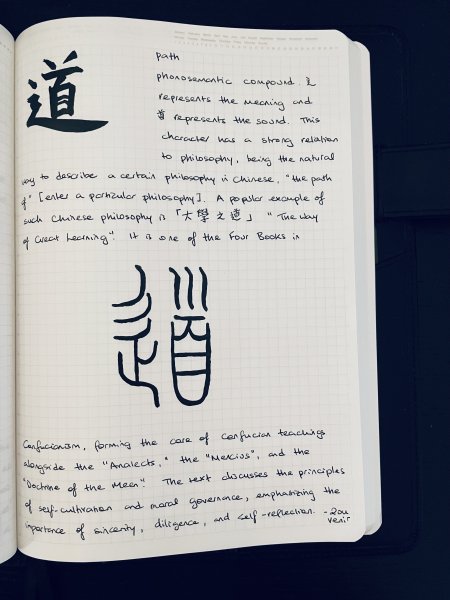
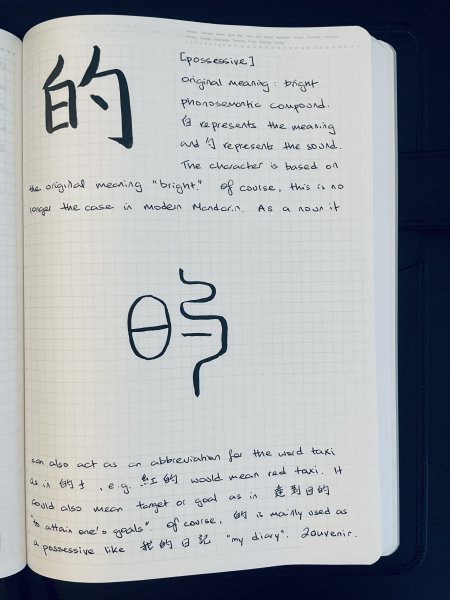
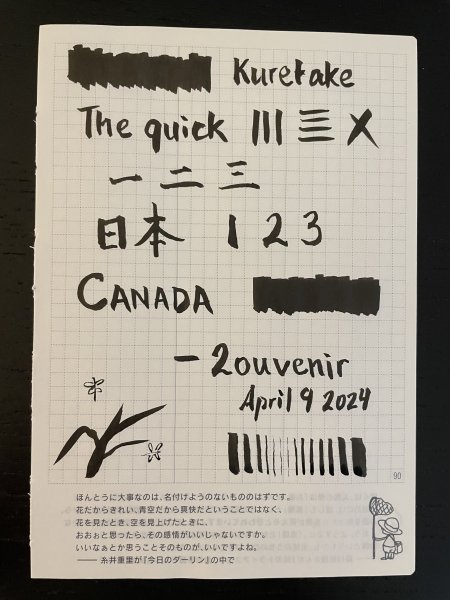
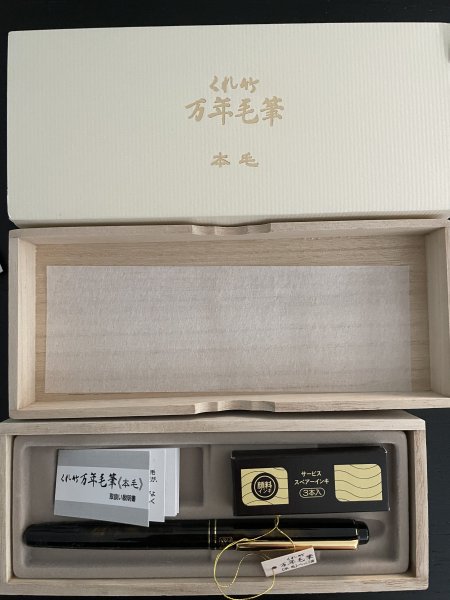

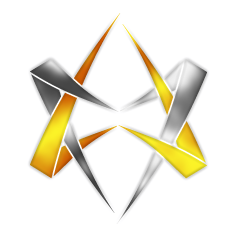










desaturated.thumb.gif.5cb70ef1e977aa313d11eea3616aba7d.gif)
